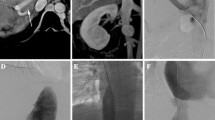Abstract
Objective
To investigate the imaging findings and hepatic artery variations encountered in patients with aberrant left gastric vein (ALGV).
Methods
A retrospective database search between January 2014 and November 2018 was carried for ALGV. The course and types (1–3) of ALGV, the presence of associated liver lesions, and coexistence of hepatic artery variations were reviewed on CT images.
Results
A total of 32 patients (22 men, 68.7%) with a mean age of 52.5 years (range 22–76 years) were found to have ALGV. The prevalence of ALGV was 0.073%. The most frequent type of ALGV was type 1 (n = 22, 68.7%), followed by type 3 (n = 7, 21.8%) and type 2 (n = 3, 9.3%). We noticed mild-to-severe parenchymal hyperdensity at the posterior aspect of segments II and III in patients with type 1 (n = 20/22) and type 2 (n = 2/3) ALGV consistent with fat sparing due to third inflow effect. Two out of seven patients with type 3 ALGV had main portal vein thrombosis; however, the presence of ALGV maintained left portal vein flow in these patients. Twelve (37.5%) patients had accompanying hepatic artery variation. Left hepatic and right hepatic artery variations were detected in 8 (25%) and 2 (6.25%) of the patients, respectively. In 2 patients, Michels type IV variation was detected.
Conclusion
Aberrant left gastric vein is associated with hepatic artery variations, which can be important for preoperative and pretransplant planning.






Similar content being viewed by others
References
Takayasu K, Aoki K, Ichikawa T, Ohmura T, Sekiguchi R, Terauchi T, Takayama T. (1990) Aberrant right gastric vein directly communicating with left portal vein system. Incidence and implications. Acta Radiol; 31:575-577
Terayama N, Matsui O, Tatsu H, Gabata T, Kinoshita A, Hasatani K (2004) Focal sparing of fatty liver in segment II associated with aberrant left gastric vein. Br J Radiol; 77:150-152
Unal E, Ozmen MN, Akata D, Karcaaltincaba M (2015) Imaging of aberrant left gastric vein and associated pseudolesions of segments II and III of the liver and mimickers. Diagn Interv Radiol; 21:105-110
Ishigami K, Sun S, Berst MJ, Heery SD, Fajardo LL (2004) Portal vein occlusion with aberrant left gastric vein functioning as a hepatopetal collateral pathway. J Vasc Interv Radiol; 15:501-504
Matsui O, Takahashi S, Kadoya M, Yoshikawa J, Gabata T, Takashima T, Kitagawa K. (1994) Pseudolesion in segment IV of the liver at CT during arterial portography: correlation with aberrant gastric venous drainage. Radiology; 193:31-35
Seong NJ, Chung JW, Kim HC, Park JH, Jae HJ, An SB, Cho BH. (2012) Right gastric venous drainage: angiographic analysis in 100 patients. Korean J Radiol; 13:53-60
Nebot-Cegarra J, Domenech-Mateu JM (1986) Intrahepatic termination of the left gastric vein (vena gastrica sinistra): a new case of this unusual anatomic variation. Anat Anz; 161:309-315
Matsui O, Kadoya M, Takahashi S, Yoshikawa J, Gabata T, Takashima T, Kitagawa K. (1995) Focal sparing of segment IV in fatty livers shown by sonography and CT: correlation with aberrant gastric venous drainage. AJR Am J Roentgenol; 164:1137-1140
Ohashi I, Ina H, Hanafusa K, Yoshida T, Himeno Y, Gomi N, Okada Y, Wakita T, Shibuya H, Ohtani S. (1997) Aberrant left gastric vein demonstrated by helical CT. J Comput Assist Tomogr; 21:996-1000
Chaib E, Bertevello P, Saad WA, Pinotti HW, Gama-Rodrigues J (2007) The main hepatic anatomic variations for the purpose of split-liver transplantation. Hepatogastroenterology; 54:688-692
Koops A, Wojciechowski B, Broering DC, Adam G, Krupski-Berdien G (2004) Anatomic variations of the hepatic arteries in 604 selective celiac and superior mesenteric angiographies. Surg Radiol Anat; 26:239-244
Ugurel MS, Battal B, Bozlar U, Nural MS, Tasar M, Ors F, Saglam M, Karademir I. (2010) Anatomical variations of hepatic arterial system, coeliac trunk and renal arteries: an analysis with multidetector CT angiography. Br J Radiol; 83:661-667
Stemmler BJ, Paulson EK, Thornton FJ, Winters SR, Nelson RC, Clary BM (2004) Dual-phase 3D MDCT angiography for evaluation of the liver before hepatic resection. AJR Am J Roentgenol; 183:1551-1557
Iezzi R, Cotroneo AR, Giancristofaro D, Santoro M, Storto ML (2008) Multidetector-row CT angiographic imaging of the celiac trunk: anatomy and normal variants. Surg Radiol Anat; 30:303-310
Perez-Saborido B, Pacheco-Sanchez D, Barrera Rebollo A, Pinto Fuentes P, Asensio Díaz E, Labarga Rodriguez F, Sarmentero Prieto JC, Martínez Díez R, Rodríguez Vielba P, Gonzálo Martín M, Rodríguez López M, de Anta Román A. (2012) Incidence of hepatic artery variations in liver transplantation: does it really influence short- and long-term results? Transplant Proc; 44:2606-2608
Michels NA (1966) Newer anatomy of the liver and its variant blood supply and collateral circulation. Am J Surg; 112:337-347
Favelier S, Germain T, Genson PY, Cercueil JP, Denys A, Krausé D, Guiu B. (2015) Anatomy of liver arteries for interventional radiology. Diagn Interv Imaging; 96:537-546
Tan CH, Peungjesada S, Charnsangavej C, Bhosale P (2010) Gastric cancer: Patterns of disease spread via the perigastric ligaments shown by CT. AJR Am J Roentgenol; 195:398-404
Unal E, Karaosmanoglu AD, Ozmen MN, Akata D, Karcaaltincaba M (2018) Computed Tomography-Based Diagnosis of Gastric Vein Invasion in Patients with Gastric Cancer. Eurasian J Med; 50:91-95
Funding
No funding was received from any source.
Author information
Authors and Affiliations
Corresponding author
Ethics declarations
Conflict of interest
All authors declare that they have no conflict of interest.
Additional information
Publisher's Note
Springer Nature remains neutral with regard to jurisdictional claims in published maps and institutional affiliations.
Rights and permissions
About this article
Cite this article
Ünal, E., Karcaaltincaba, M. Aberrant left gastric vein is associated with hepatic artery variations. Abdom Radiol 44, 3127–3132 (2019). https://doi.org/10.1007/s00261-019-02076-2
Published:
Issue Date:
DOI: https://doi.org/10.1007/s00261-019-02076-2




